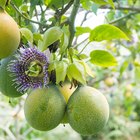Introduction
Images of kitties snoozing contentedly in the garden sun may have their appeal, but life isn't always so accommodating. Keeping houseplants or planting a garden that is as pleasing to cats as it is to cat owners takes thought; many otherwise-delightful flowers aren't cat safe. Consider the colorful, popular plants called geraniums (Pelargonium spp.). Tender perennials in U.S. Department of Agriculture plant hardiness zones 9 through 10, they're radiant, summer-blooming annuals elsewhere. For all their charms, scented geraniums have one major drawback: They're poisonous to cats.
Why Cats Eat Geraniums
The American Society for Prevention of Cruelty to Animals estimates that about one in three cats occasionally snacks on vegetation. Suggested reasons for this behavior include a desire for supplemental nutrients, the fun of pouncing on wind-tossed leaves or the feline yearning to be the center of attention. Whatever impels them, geranium-munching cats ingest two toxins, geraniol and linalool. To become really sick, kitty would have to work his way through several geranium plants or the equivalent dose if ingested in the form of an essential oil or jams. Ingestion of even a small amount of the compounds, however, will make him uncomfortable. He may experience loss of appetite, vomiting, anorexia, ataxia, depression, or skin irritation/dermatitis around his mouth where the toxins penetrated the fur.
When Cats Get Geranium Poisoning
- Get him away from the plant immediately.
- Use a soft, clean water-dampened cloth to clear geranium debris from in and around his mouth.
- Call your veterinary hospital, the poison control center or the Pet Poison Helpline for instructions, even if he's not showing any symptoms.
- If you're told to take the cat to the vet, bring along pieces of the geranium labeled as Pelargonium.
- If he vomits, collect a sample in a sealed plastic bag for the vet to examine.
Creating a Cat-Safe Garden
From the minute you plant geraniums in the spring until they die back in fall, don't let kitty near them without supervision. Even better, make a cat enclave free of all toxic plants and equipped with a sand-filled litter box and fresh water.
Other poisonous plants to watch out for include:
- Tulips
- Aloe Vera
- Azaleas
- Daffodils
- Hyacinth
- Peppermint
For a special treat, add catnip (Nepata x faassenii) to the kitty corner. It's hardy in USDA zones 3 through 8. Where summers are cool, plant it in full sun; otherwise, afternoon shade is best.
If your pet still doesn't get the message, periodically sprinkle fresh coffee grounds around the geraniums to discourage his visits.
The ASPCA suggests spraying a cotton ball with a bitter-flavored taste deterrent, putting it in your cat's mouth and letting him spit it out. Make sure he's exposed to it long enough to remember the deterrent' scent. Then spray the deterrent around the geraniums daily for the next two weeks; that should be long enough for him to lose all interest in the plants. Bitter deterrent sprays are available at pet supply stores.
Cat-Friendly Geraniums
Don't confuse Pelargonium geraniums with nontoxic, hardy geraniums (Geranium spp.). Also known as cranesbills, they're suitable for USDA zones 3 through 8, depending on variety. Low, sprawling plants that make excellent ground covers, cranesbills replace Pelargoniums' globes of red, pink, white or salmon blooms with modest single pink, blue, magenta, purple or white flowers.
Related Articles

What Causes Strawberries to Mold?

How to: Eucalyptus Oil as a Flea ...

How to Make Elderberry Jam

Tanqueray Gin Ingredients

How to Keep Mosquitoes Away When ...

How to Pick Hawthorne Berries

Food That Ants Won't Eat

Can I Use Kale That Has Yellowed?

How to Eat a Maypop When Ripe

List of Wild Edible Plants & Berries in ...

How to Use Joy Instead of Dawn to Kill ...

What to Get for Someone Whose Cat Died

Burdock Root for Acne

Swollen Lymph Nodes in Horses

Herbs That Cause Photosensitivity

Can You Eat the Green Stem of a ...

Foods for Eliminating Smoker Breath

The Meaning of Allium Flowers

How to Preserve Mangoes

The Culinary Uses of the Eucalyptus Leaf
References
Writer Bio
Passionate for travel and the well-written word, Judy Wolfe is a professional writer with a Bachelor of Arts in English literature from Cal Poly Pomona and a certificate in advanced floral design. Her thousands of published articles cover topics from travel and gardening to pet care and technology.